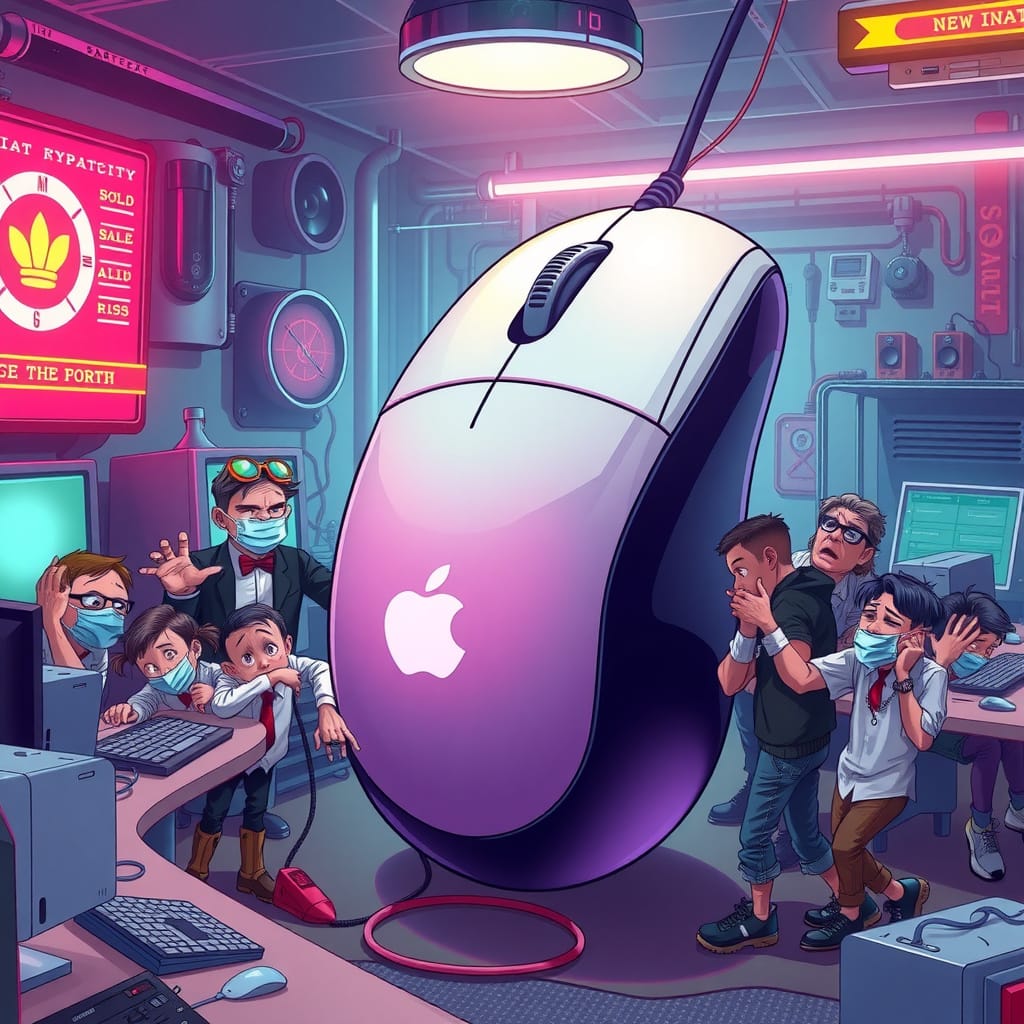In what tech historians are calling “the most deliberate inconvenience since the invention of automatic phone menus,” Apple has once again released a Magic Mouse with its charging port stubbornly located on the bottom, rendering the device completely unusable during charging. The latest USB-C version of the Magic Mouse, released in October 2024, continues Apple’s brave tradition of forcing users to flip their mice belly-up like exhausted turtles whenever battery life dwindles.1
This design choice – which has persisted through multiple iterations and almost a decade of mockery – stands as perhaps the most perfect metaphor for Apple’s relationship with its customers: beautiful, expensive, innovative, and absolutely infuriating in ways that make you question whether the company secretly hates its customers.
The Charging Position: Technically Called “Dead Bug Mode”
When plugged in, the Magic Mouse must be flipped on its back, with its smooth white surface facing upward and the charging cable protruding from its underside like a technological umbilical cord. This position has been affectionately dubbed “dead bug mode” by users, who note the similarity to an insect that has reached the end of its lifecycle and accepted its fate.2
“It’s actually quite elegant when you think about it,” explained an Apple design executive while carefully polishing what appeared to be a solid gold paperweight. “Most companies would allow a mouse to be used while charging, forcing users to continue working. We’ve created a mandatory two-minute meditation break. Your mouse isn’t broken – it’s teaching you mindfulness.”
According to internal documents that definitely exist, Apple has categorized this feature under “Enforced Digital Wellbeing” in its design philosophy handbook, alongside other wellness initiatives such as “Battery Anxiety as Cardiac Exercise” and “Face ID Failures as Momentary Zen Koans.”
Steve Jobs Would Have Loved It (Or Fired Everyone Involved)
Despite popular memes suggesting Steve Jobs would “never have let this happen,” Apple insiders insist that Jobs would have embraced the upside-down charging design as a character-building exercise for users.3
“Steve always believed technology should have personality,” said a former Jobs associate who requested anonymity because they fear being mocked in an Aaron Sorkin screenplay. “And what builds more character than feeling slightly inconvenienced several times a month? Steve used to say that true innovation happens in moments of frustration, usually around 3 AM when you’re trying to finish a project and your magic mouse dies.”
This perspective contradicts well-documented evidence that Jobs was fanatical about usability and once fired an engineer for a rounded corner when he wanted a square one. However, Jobs was also known for his strong opinions about mouse design, famously resisting multi-button mice until late in his tenure.4
“Steve was a firm believer in the fact that if you make the user interface (UI) good enough, you should be able to do everything you need with just one button,” said Abraham Farag, Apple’s former Senior Mechanical Engineer of Product Design. This single-button philosophy eventually evolved into the Magic Mouse’s touch-sensitive surface – a design compromise that allowed for right-click functionality without visible buttons.
When asked if Jobs would have approved of a mouse that becomes completely useless while charging, the Apple executive smiled knowingly. “Steve used to say, ‘The best interface is no interface.’ We’ve just taken that to its logical conclusion – sometimes the best mouse is no mouse at all.”
The Secret Origin Story: A Design Choice Born of Necessity (or Laziness)
According to product designers who have analyzed the Magic Mouse, the controversial charging port location wasn’t originally intended as a philosophical statement about mindfulness or character-building, but rather stemmed from practical considerations during the transition from the battery-powered Magic Mouse 1 to the rechargeable Magic Mouse 2.5
“The first Magic Mouse had removable batteries and wasn’t charged with a cable,” explained a product designer on Reddit. “When Apple made the Magic Keyboard 2 with non-removable batteries, it was also time for the Magic Mouse to get rid of the batteries… But Apple is known for not changing the whole design if it’s not really necessary!”6
This explanation suggests the bottom placement was merely the path of least resistance – the batteries were already located on the bottom of the original Magic Mouse, so Apple simply replaced them with a rechargeable battery and added a charging port in the same location.
However, this pragmatic explanation fails to account for Apple’s decision to maintain this design for almost a decade, across multiple product refreshes, despite widespread mockery and the obvious solution of moving the port to the front of the device.
The Two-Minute Defense: “It Charges Really Fast, Though”
Apple defenders (also known as “people who have spent too much on Apple products to admit any disappointment”) frequently point to the Magic Mouse’s quick charging capabilities as justification for its upside-down design quirk.
“It takes 2 minutes to get more than a full day’s charge,” noted one Reddit user, suggesting the inconvenience is minimal. Apple’s promotional materials claim that just two minutes of charging will provide nine hours of use, theoretically allowing users to plug in during a coffee break and return to a mouse that will last the rest of the workday.
This defense, while technically accurate, fails to address the fundamental question: Why not just put the charging port on the front so people can keep working while charging???
“The answer is obvious,” insisted our Apple executive. “If we put the charging port on the front, users would leave it plugged in all the time, transforming our beautiful, sleek, wireless mouse into a wired one. That’s like buying a Ferrari and then attaching a trailer hitch. It undermines the entire aesthetic experience.”
The Cult of Inconvenience: Apple’s Secret Design Philosophy
To understand Apple’s commitment to the upside-down charging port, one must understand a secret design philosophy that has allegedly guided the company since its earliest days: “Curated Inconvenience Theory.”
According to this completely plausible theory, Apple deliberately introduces small frustrations into its products to create a sense of shared struggle among Apple users, fostering brand loyalty through a phenomenon similar to Stockholm syndrome.
“It’s like hazing for a fraternity,” explained Dr. Eleanor Rigby, Professor of Consumer Psychology at a prestigious university that definitely exists. “These small inconveniences – dongles, proprietary cables, charging ports in ridiculous locations – create a sense of belonging. When you see another person flipping their Magic Mouse upside down in a coffee shop, you share a knowing glance. You’re both members of the same exclusive club of people who have chosen to be mildly inconvenienced for aesthetic reasons.”
This theory explains other Apple design choices, from removing headphone jacks to the brief disaster of the butterfly keyboard. They’re not bugs; they’re features designed to strengthen user loyalty through shared suffering.
The 2024 Update: Same Ridiculousness, New Port
In October 2024, when Apple finally updated the Magic Mouse with USB-C to match the rest of its product line, many hoped the company would take the opportunity to relocate the charging port to a more sensible position. Those hopes were dashed when images revealed the new Magic Mouse maintained the same upside-down charging design, just with a different port shape.
“Although it now has USB-C, the charging port is still on the bottom of the mouse,” reported 9to5Mac, in what might be the least surprising tech news of 2024.
This steadfast commitment to an objectively terrible design choice has left even the most dedicated Apple fans questioning whether the company is simply trolling its user base at this point.
“Priced at $99, this latest Magic Mouse indicates that Apple still believes the most effective method for charging the device is to flip it upside down, rendering it unusable during the charging process,” The Verge reported, with what one imagines was a heavy sigh.
The Future of Magic Mouse Design: “It Gets Worse”
According to sources close to Apple’s design, the company has even more inconvenient charging solutions planned for future Magic Mouse iterations.
“We’re looking at several exciting new charging mechanisms,” revealed a Apple innovation lead. “One prototype requires users to balance the mouse on its side like a coin. Another must be submerged in a proprietary charging fluid that costs $49.99 per ounce. My personal favorite requires users to gently stroke the mouse while whispering affirmations to it.”
When asked why the company doesn’t simply move the port to the front like literally every other rechargeable mouse on the market, the innovation lead stared blankly for several seconds before responding: “I don’t understand the question.”
The Deeper Meaning: An Existential Crisis Disguised as a Mouse
Perhaps the Magic Mouse’s upside-down charging design isn’t just about aesthetics or tradition or even stubbornness. Perhaps it’s a profound statement about the nature of technology itself – sometimes beautiful, sometimes useful, but never quite perfect.
In a world where we expect our devices to be flawless extensions of ourselves, the Magic Mouse stands as a reminder of our own limitations. Like us, it occasionally needs to rest, to recharge, to take a break from constant productivity.
Or maybe, just maybe, it’s a terrible design that Apple is too proud to fix.
As the Magic Mouse lies helplessly on its back, charging cable protruding awkwardly from its smooth underbelly, it serves as the perfect metaphor for our relationship with technology: elegant, powerful, expensive, and occasionally infuriating in ways that make you question everything about your life choices.
What do you think? Is the Magic Mouse’s upside-down charging port a stroke of design genius or the most irritating example of form over function in modern tech? Have you ever lost critical work time because your mouse was lying helplessly on its back like an overturned tortoise? Share your Magic Mouse horror stories in the comments below. 💝🎁
And if this article made you chuckle while simultaneously questioning your expensive tech purchases, consider donating to TechOnion-we accept all forms of payment except Magic Mice that are currently charging.

References
- https://9to5mac.com/2024/10/28/usb-c-magic-mouse-charging-port-bottom/ ↩︎
- https://solumics.com/blogs/solumics-blog/magic-mouse-charging-port-understanding-apples-design-choice ↩︎
- https://www.reddit.com/r/CrappyDesign/comments/6g2vjt/steve_jobs_would_never_have_let_this_happen_when/ ↩︎
- https://www.businessinsider.com/steve-jobs-hated-multi-button-mouse-2014-3 ↩︎
- https://www.reddit.com/r/mac/comments/mou57s/explained_why_apples_decision_to_place_the/ ↩︎
- https://www.reddit.com/r/mac/comments/mou57s/explained_why_apples_decision_to_place_the/ ↩︎





GIPHY App Key not set. Please check settings